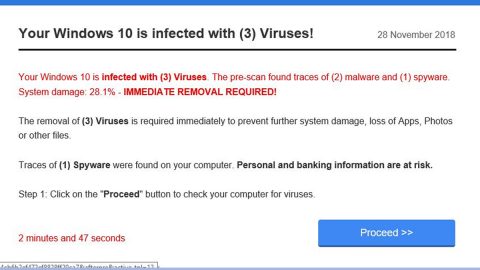Azer Ransomware Description

The Azer Ransomware is another encryption ransomware Trojan that appeared in early June 2017. This Azer Ransomware is a variant of CryptMix which is well-known ransomware Trojan. The Azer Ransomware simply encrypts its victims’ files through a strong encryption method and then appends the string ‘-email-[E-MAIL].AZER’ to the end of eachinfected file’s name. The Azer Ransomware will then show a ransom note demanding a ransom payment so it can decrypt your files. The developers of the Azer Ransomware infection have been known to use two email addresses to establish contact with the victims of the attack: ‘[email protected]’ and ‘[email protected].’ These email addresses had been noticed in the previous ransomware attacks, especially in the Donald Trampo Ransomware Trojan attack. Because of this, it is very clear that it’s the same group who developed the Azer Ransomware who are also responsible for these previous attacks. The most common way in which the Azer Ransomware can get the infection is through the spam email messages containing corrupted attachments.
Another Game-Named Ransomware Attack
When the victim opens the corrupted email attachment, there will a compromised macro script that will try to attempt to download and install the Azer Ransomware on the victim’s computer even without the use’s consent. A User Account Control pop-up message will be displayed. Computer users that inadvertently allow the script to run will allow the Azer Ransomware to be installed. Once the Azer Ransomware gets through in, it will scan the victim’s computer to target files which are usually user-generated files such as media files and commonly used documents. Often, the Azer Ransomware runs as an executable file named ‘gangbang.exe’ on the victim’s computer. During its attack, the Azer Ransomware will utilize a combination of the RSA and AES encryptions to make the victim’s files inaccessible and unreadable. Sadly, the files encrypted by the Azer Ransomware attack will no longer be recoverable and will be identified easily because it will change the files and it will have file extension appended to the end of the files’ names. Basically, the Azer Ransomware further modifies the infected files’ name by encrypting the files’ name and exchanging it with a string of numbers and letters.
The Azer Ransomware Demands Ransom
The Azer Ransomware displays its ransom note in the form of a text file named ‘_INTERESTING_INFORMACION_FOR_DECRYPT.TXT,’ which is seen on the infected computer’s Desktop. Below is the full text that are usually contained in the Azer Ransomware ransom message:
‘All you files encrypted
For decrypt write to email:
[email protected]
[email protected]
You ID – [RANDOM CHRACTERS]’
Although not mentioned in the Azer Ransomware ransom note, the average ransom payment they demanded is anapproximate of a $300 USD, to be paid in Bitcoins. But, previously in the Azer Ransomware family have demanded amounts as low as $50 USD and as high as $1800 USD. Regardless of the amount, the computer’s security analysts strongly advise computer users to refrain from paying the Azer Ransomware ransom amount because it is uncertain that you can decrypt your files after payment will be paid. Developers don’t care about your files.
How to deal with the Azer Ransomware?
Since the files encrypted by the Azer Ransomware attack become inaccessible and unreadable no matter what you try to do, computer security researchers strongly advise computers to take steps to safeguard their data which is the very basic precaution. The best protection against ransomware Trojans and the like like the Azer Ransomware is to have file backups on an external device or the cloud. When you have the files from a backup copy, computers users don’t need to pay a ransom, and removing the leverage the con artists gain over their victims. In fact, file backups remain the best protection against the Azer Ransomware and similar ransomware Trojans and all sort of viruses, and if a point where most computers have file backups is reached, then these attacks will likely disappear since they will no longer be effective.
Asidefrom file backups, another reliable security program is a very important part of protecting your data from attacks like the Azer Ransomware. Since the Azer Ransomware may be delivered through spam email attachments from unknown sources, spam email filters and learning how to handle this content safely are also an important part of protecting your computer system.
How to Remove Azer Ransomware from Windows
- Tap Win+E to launch your File Explorer.
- Delete the malicious file you saved from the spam. You may find it in default download folders: %Temp%, Downloads, Desktop, %Appdata%, and %Localappdata%
- Delete the random-name malicious file from “%AppData%” (it could be called “BC0EBCF2F2.exe”).
- Delete the ransom note files (“_INTERESTING_INFORMACION_FOR_DECRYPT.TXT”) from all directories.
- Empty the Recycle Bin.
- Tap Win+R and enter regedit. Hit the Enter key.
- Locate and remove the two random-name value names in “HKEY_CURRENT_USER\Software\Microsoft\Windows\CurrentVersion\Run” registry key where the value data contains the location of the malicious file in “%AppData%” (“BC0EBCF2F2.exe” or something similar).
- Close the editor and reboot your computer.
In simple terms:
Azer Ransomware Trojan is a severe threat to your files and your computer system if it manages to slither on. This ransomware infection basically encrypts your personal important files in a short time and render them useless and inaccessible and unrecoverable. As to the ransom note, they require you to send an e-mail to these crooks to receive further instructions about the payment for the decryption key. Although it is all up to you what you decide to do but we definitely strongly recommend you not to pay any amount of ransom fee they set. Because unfortunately, there is little chance for you to get anything in return other than another malicious attack. If you have a backup, you can copy your clean files back after you eliminate the Azer Ransomware competely from your system. If you need proper protection to feel secure while you are using your computer, we recommend that you invest and install an up-to-date anti-malware program to keep you protected.
How to automatically remove Azer Ransomware?
Use an anti-malware program
We recommend using SpyRemover Pro, a highly effective and widely used malware removal program to clean your computer of Azer Ransomware. In addition to Azer Ransomware, this program can detect and remove the latest variants of other malware.
SpyRemover Pro has an intuitive user interface that is easy to use. To get rid of Azer Ransomware, the first step is to install it, scan your computer, and remove the threat.
To remove Azer Ransomware from your computer using SpyRemover Pro, you need to perform the following steps:
Basic steps of SpyRemover Pro:
Step 1. Run SpyRemover Pro installer
Click on the .exe file that just downloaded in the lower right corner of your browser window.
Step 2. Click Yes
Click Yes to accept the User Account Control settings dialog.
Step 3. Foll0w setup instructions
Follow the instructions to get SpyRemover Pro set up on your computer and you will be good to go!











